
Concept explainers
a.
Use a graphing utility to graph the first
a.
Answer to Problem 1PS
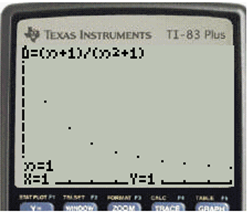
Explanation of Solution
Calculation:
Consider the following sequence
To graph the sequence, set the mode to sequence and dot as shown below.
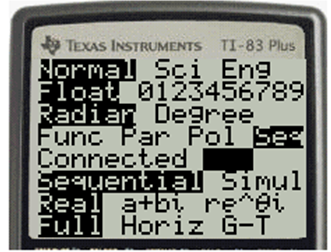
Enter in the sequence using the
The display is shown below
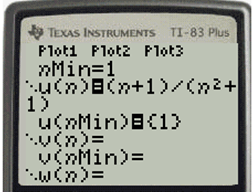
Now press WINDOW button and set the range of the axis
The display is shown below
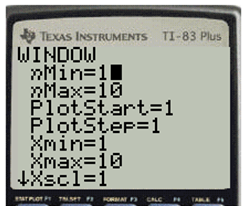
Press the GRAPH button to draw the graph of the sequence
Hence, the display is shown below
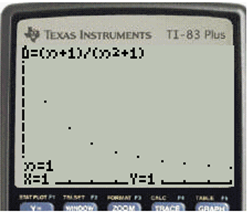
b.
Estimate the value of
b.
Answer to Problem 1PS
Explanation of Solution
Calculation:
From the graph, note that as
Hence,
c.
Complete the table.
c.
Answer to Problem 1PS
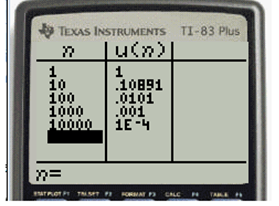
Explanation of Solution
Calculation:
To draw the table, set the WINDOW as shown below
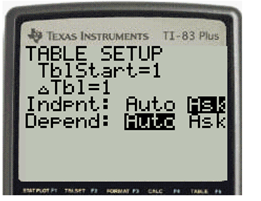
Hence, press the TABLE button and enter the value of
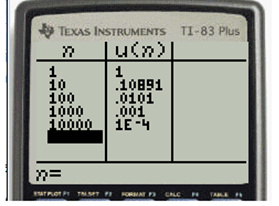
d.
Determine the value of
d.
Answer to Problem 1PS
Explanation of Solution
Calculation:
From the table in part (c), note that as
Hence, when
Hence,
Chapter 9 Solutions
EBK PRECALCULUS W/LIMITS
- Solve : X + sin x = 0. By the false positioning numerical methodarrow_forwardSolve: X + sin X = 0 by the false positionining numerical methodarrow_forwardOn from the equation: 2 u = C₁ + C₂ Y + Czy + Cu y³ Find C₁, C₂, C3 and Cy Using these following Cases : (a) 4=0 at y=0 (b) U = U∞ at y = 8 du (c) at Y = S ду --y. ди = 0 at y = 0 бугarrow_forward
- Tips S ps L 50. lim x2 - 4 x-2x+2 51. lim 22 - X 52. 53. x 0 Answer lim x 0 lim 2-5 X 2x2 2 x² Answer -> 54. lim T - 3x - - 25 +5 b+1 b3b+3 55. lim X x-1 x 1 Answer 56. lim x+2 x 2 x 2 57. lim x²-x-6 x-2 x²+x-2 Answer-> 23-8 58. lim 2-22-2arrow_forwardS 36. lim 5x+2 x-2 37. lim √√2x4 + x² x-3 Answer-> 2x3 +4 38. lim x12 √ x² + 1 √√x² + 8 39. lim x-1 2x+4 Answer 40. lim x3 2x x√x² + 7 √√2x+3arrow_forwardSee imagearrow_forward
- Enter your answer in interval notation. No decimal entries allowed. Type oo (lower case o) for ∞ and -oo for -∞ if needed. Domain: Question Help: Message instructorarrow_forwardWrite a formula for the function g that results when the graph of the function f(x) = = 4 X is reflected about the y-axis, horizontally compressed by a factor of 2, shifted 7 units left, reflected about the x-axis and shifted 3 units up. g(x): = Question Help: Message instructorarrow_forwardQuestion 7 4 pts 1 Details The value of China's exports of automobiles and parts (in billions of dollars) is approximately f(x) = 1.8208e0.3387x, where x = 0 corresponds to 1998. In what year did/will the exports reach $10.4 billion?arrow_forward
 Calculus: Early TranscendentalsCalculusISBN:9781285741550Author:James StewartPublisher:Cengage Learning
Calculus: Early TranscendentalsCalculusISBN:9781285741550Author:James StewartPublisher:Cengage Learning Thomas' Calculus (14th Edition)CalculusISBN:9780134438986Author:Joel R. Hass, Christopher E. Heil, Maurice D. WeirPublisher:PEARSON
Thomas' Calculus (14th Edition)CalculusISBN:9780134438986Author:Joel R. Hass, Christopher E. Heil, Maurice D. WeirPublisher:PEARSON Calculus: Early Transcendentals (3rd Edition)CalculusISBN:9780134763644Author:William L. Briggs, Lyle Cochran, Bernard Gillett, Eric SchulzPublisher:PEARSON
Calculus: Early Transcendentals (3rd Edition)CalculusISBN:9780134763644Author:William L. Briggs, Lyle Cochran, Bernard Gillett, Eric SchulzPublisher:PEARSON Calculus: Early TranscendentalsCalculusISBN:9781319050740Author:Jon Rogawski, Colin Adams, Robert FranzosaPublisher:W. H. Freeman
Calculus: Early TranscendentalsCalculusISBN:9781319050740Author:Jon Rogawski, Colin Adams, Robert FranzosaPublisher:W. H. Freeman
 Calculus: Early Transcendental FunctionsCalculusISBN:9781337552516Author:Ron Larson, Bruce H. EdwardsPublisher:Cengage Learning
Calculus: Early Transcendental FunctionsCalculusISBN:9781337552516Author:Ron Larson, Bruce H. EdwardsPublisher:Cengage Learning





